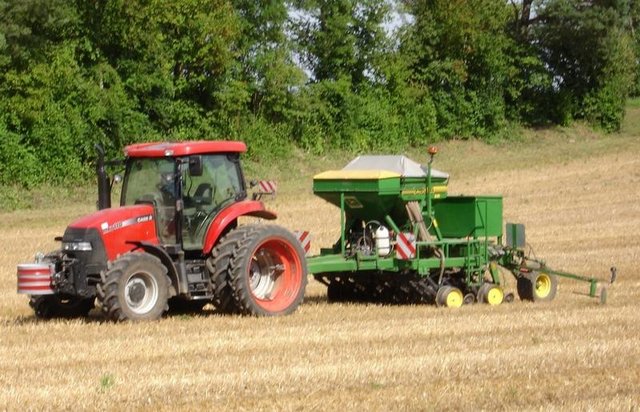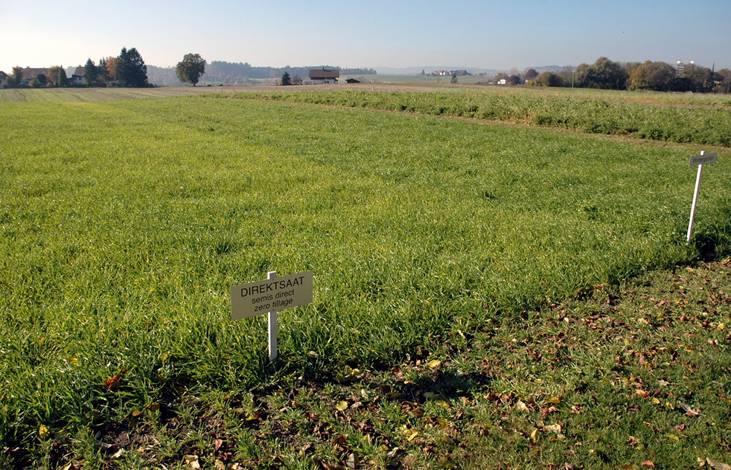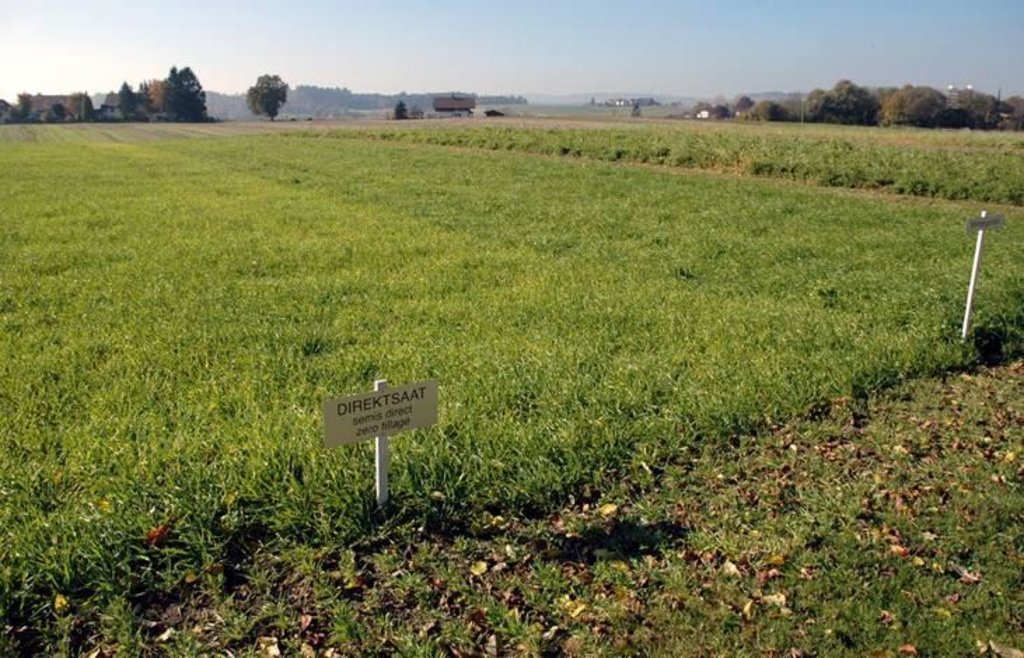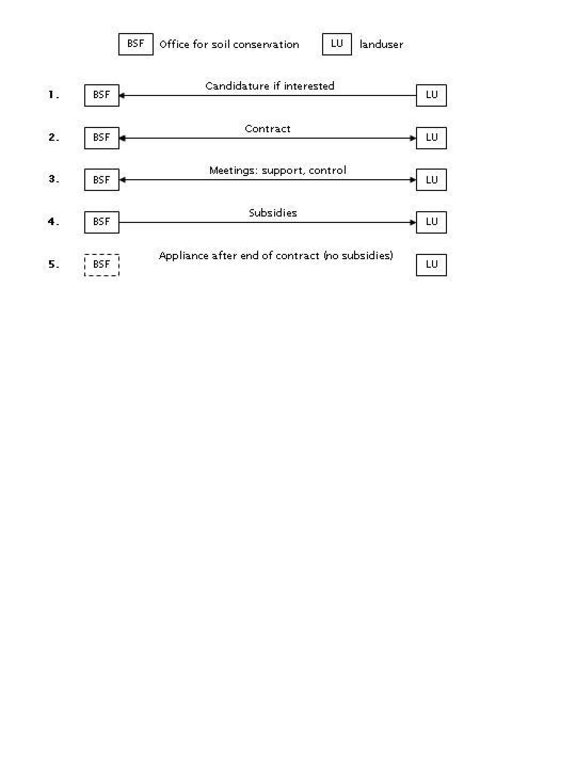Subsidies for conservation agriculture [سويسرا]
- تاريخ الإنشاء:
- تحديث:
- جامع المعلومات: Unknown User
- المحرر: –
- المُراجع: David Streiff
Umstellungsverträge
approaches_2632 - سويسرا
عرض الأقسام
توسيع الكل طي الكل1. معلومات عامة
1.2 تفاصيل الاتصال بالأشخاص الرئيسيين لمصدر المعلومات والمؤسسات المعنية بتقييم وتوثيق النهج
الشخص (الأشخاص) الرئيسي لمصدر المعلومات
متخصص في الإدارة المستدامة للأراضي:
Wyler Roman
سويسرا
متخصص في الإدارة المستدامة للأراضي:
Hofer Peter
+41 (0)31 970 53 37
Peter.hofer@vol.be.ch
Amt für Landwirtschaft und Natur des Kantons Bern LANAT
Rütti, 3052 Zollikofen
سويسرا
اسم المؤسسة (المؤسسات) التي سهلت توثيق/تقييم النهج (إذا كان ذلك على صلة)
Amt für Landwirtschaft und Natur des Kantons Bern (LANAT) - سويسرا1.3 الشروط المتعلقة باستخدام البيانات الموثقة من خلال WOCAT
يوافق جامع المعلومات والشخص (لاشخاص) الرئيسي لمصدر المعلومات على الشروط المتعلقة باستخدام البيانات الموثقة من خلال WOCAT:
نعم
1.4 المراجع الخاصة باستبيان(استبيانات) تقنيات الإدارة المستدامة للأراضي

Direct seeding [سويسرا]
A cropping system which allows to plant the seeds directly into the soil without ploughing. The soil is covered with plant remainders.
- جامع المعلومات: Unknown User
2. وصف نهج الإدارة المستدامة للأراضي
2.1 وصف موجز للنهج
Land users commit to apply conservation agriculture on parts of their land for a period of 5 years. In return they get subsidies during this period.
2.2 وصف تفصيلي للنهج
وصف تفصيلي للنهج:
Aims / objectives: The Swiss environment protection law defines that soil fertility must be conserved on a long term basis. The cantons have to execute this national law. The way this is done differs from canton to canton. In this study the strategy of the canton of Berne is documented. It has three major goals: The prevention of soil erosion, the reduction of nitrate wash out and the prevention of soil compaction.
Methods: To reach these goals, farmers who accept to use conservation technologies can get additional subsidies for a period of 5 years. Furthermore they are supported by advisors. In this way land users are encouraged to change to soil conservation technologies, financial risk during the establishment phase is reduced due to the subsidies. The approach consist basically of a contract between land users and the office for soil conservation, in which land users commit to apply only soil conservation technologies on parts or on all their land during a period of 5 years. During that time direct seeding must be applied at least 2 times for main crops and for half of the catch crops. For the remaining crops ploughing is not allowed either. Technologies which reduce the reworking of the soil such as maize strip tillage ('Streifenfrässaat') or mulching need to be applied. In return land users get subsidies (during 5 years) which depend on the crop and the technology used. The highest subsidies are granted if direct seeding is used. The office for soil conservation is running a demonstration study comparing direct seeding to conventional agriculture. This helps land users to estimate the effects the new technology would have when applied in practice. If a specific farm receives the subsidies depends on whether in the running year there is still financial resources for the program. Resources have been limited by the government. Additionally it depends on where the farm is located. Farms that located in regions of major nitrate contamination, enhanced risk of eronsion or soil compaction or in regions with drinking water sources or polluted surface water are incorporated first. Land users can have their whole farm or single fields under contract. However a specific field can not be under contract for more than one period (5 years). As soon as a farmer gets a contract, details about which crop to plant where and when, with which technology are discussed by the farmer and an advisor.
Other important information: The goal is to find the best solution for every land user. Meetings of that kind take place on a regular basis. Besides supporting the farmer, advisors also check if conservation agriculture technologies are really being applied. After the 5 years under contract, it is the land users choice whether they want to continue using conservation technologies or not. Monitoring of the office for soil conservation shows that 85% keep on using conservation technologies. Its seems that the approach has a long term influence and subsidies are needed in the beginning only.
2.3 صور عن النهج
2.5 البلد/المنطقة/المواقع التي تم تطبيق النهج فيها
البلد:
سويسرا
المنطقة/الولاية/المحافظة:
Canton of Berne
Map
×2.6 تواريخ بدء وإنهاء تنفيذ النهج
أشر إلى سنة البدء:
1996
التعليقات:
It is possible to get subsidies in the whole canton of Berne. Cropland area in the canton is 539 km2, 2517 ha were under contract in the year 2006.
2.7 نوع النهج
- قائم على مشروع/برنامج
2.8 الغايات/الأهداف الرئيسية للنهج
The Approach focused on SLM only
Spreading of conservation agriculture in areas with an enhanced risk for soil erosion and or washing out of nutritients. Good quality support so that farmers will not have lower crop yield due to the technology and therefore continue using conservation agriculture after 5 years without external support.
The SLM Approach addressed the following problems: Water erosion under intense rainfall. Washing out of Nitrate to the ground water. Soil compaction.
2.9 الظروف التي تمكن أو تعيق تنفيذ التقنية/التقنيات المطبقة بموجب النهج
المعايير والقيم الاجتماعية /الثقافية/ الدينية
- معيق
Ploughing is an important part of the tradition of agriculture. People are very critical towards no-tillage technologies, since they don't fit the common understanding of agriculture.
Treatment through the SLM Approach: The people working in the project are farmers themselves. They can give on their practical experience. Furthermore a demonstration study can be visited
توفر/الوصول إلى الموارد والخدمات المالية
- معيق
Most farmers have achinery for conventional agriculture. To change to conservation agriculture major investments need to be done or contractors need to be tasked. Furthermore crop yield can be lowered in the beginning.
Treatment through the SLM Approach: When changing to conservation agriculture farmers are supported financially for a period of 5 years.With this money the risk in case of crop failure ond the costs for a contractor are lowered.farmers can test a new techniquewithout major expenses or risks
الإطار القانوني (حيازة الأراضي، وحقوق استخدام الأراضي والمياه)
- معيق
If the owner of the farm changes, the new owner often returns to conventional agriculture.
Treatment through the SLM Approach: No solution inside the project
The existing land ownership, land use rights / water rights hindered a little the approach implementation In Switzerland the number of farms is decreasing. New owners of land sometimes change back to conventional agriculture. It is possible however, that the new owner introduces conservation technologies.
غير ذلك
- معيق
In Switzerland there are subsidies to support farmers in hilly terrain. This encourages farmers plant crops on steeper slopes and therefore enhances the risk of erosion. This is not a constraint for the technology however.
Treatment through the SLM Approach: Conservation agriculture helps to reduce erosion. However the project cannot change the fact, that these subsidies enhance the risk of erosion.
3. المشاركة وأدوار الأطراف المعنية
3.1 أصحاب المصلحة المعنيون بالنهج وأدوارهم
- مستخدمو الأراضي المحليون/المجتمعات المحلية
Contracts are signed by the office for soil conservation and the head of the farm, who in general is male. The decision about which technology is applied is usually taken at the household level including both women and men.
- متخصصون في الإدارة المستدامة للأراضي / مستشارون زراعيون
- الحكومة الوطنية (المخططون، صانعو القرار)
The national government tasked the cantons with soil conservation. Therefore approaches differ from canton to canton.
3.2 انخراط مستخدمي الأراضي المحليين/المجتمعات المحلية في المراحل المختلفة للنهج
| انخراط مستخدمي الأراضي المحليين/المجتمعات المحلية | حدد من شارك وصف الأنشطة | |
|---|---|---|
| المبادرة/التحفيز | غير موجود | The project was introduced through the office for soil conservation |
| التخطيط | تفاعلي | Landusers who wish to get subsidies have contact the office for soil conservation. It is the land users decision on which of their fields they want apply the technology. |
| التنفيذ | الدعم الخارجي | Land user get subsidies for a period of 5 years, during which they have to apply soil conservation technologies. To actually use the technology they task a contractor or do the work on their own. |
| الرصد/التقييم | تفاعلي | As there are discussions with the advisor on a regular basis, the implementation of the technology is monitored both by the farmer and the advisor. |
| Research | غير موجود | There is a demonstration study where direct seeding and conventional agriculture is compared. |
3.3 مخطط التدفق (إذا كان متاحًا)
الوصف:
Interactions between the office for soil conservation and land users during the progression of the project.
المؤلف:
Roman Wyler
3.4 اتخاذ القرار بشأن اختيار تقنية/تقنيات الإدارة المستدامة للأراضي
حدد من الذي قرر اختيار التقنية/التقنيات التي سيتم تنفيذها:
- متخصصون في الإدارة المستدامة للأراضي بشكل أساسي، بعد التشاور مع مستخدمي الأراضي
اشرح:
The decisions were taken by the office for soil conservation. Since these people are working as farmers, too, land users perspective could be included.
Decisions on the method of implementing the SLM Technology were made by mainly by land users supported by SLM specialists. To get the subsidies criteria from the contract need to be accepted. Besides this, land users can decide on their own how land is cultivated.
4. الدعم الفني وبناء القدرات وإدارة المعرفة
4.1 بناء القدرات/التدريب
هل تم تقديم التدريب لمستخدمي الأراضي / الأطراف المعنيين الآخرين؟:
كلا
4.2 خدمة استشارية
هل يملك مستخدمو الأراضي وصولا إلى خدمة استشارية؟:
نعم
حدد ما إذا كانت الخدمة الاستشارية متوفرة:
- في حقول مستخدمي الأراضي
وصف/تعليقات:
nnual meetings between land user and advisor; Key elements: Technical support, Planning of crop rotation and technologies applied, Monitoring
Advisory service is quite adequate to ensure the continuation of land conservation activities; Following a study of the office for soil conservation most land users continue to use conservation technologies after the end of the contract.
4.3 تعزيز المؤسسات (التطوير التنظيمي)
هل تم إنشاء أو تعزيز مؤسسات من خلال هذا النهج؟:
- نعم، قليلا
حدد المستوى (المستويات) التي تم فيها تعزيز أو إنشاء المؤسسات:
- محلي
اعط مزيدا من التفاصيل:
The office for soil conservation was involved in Swiss no-till, which is a platform to exchange knowledge.
4.4 الرصد والتقييم
هل يشكل الرصد والتقييم جزءا من النهج؟:
نعم
التعليقات:
bio-physical aspects were regular monitored by 0 through observations; indicators: advisory meetings
technical aspects were regular monitored by 0 through observations; indicators: advisory meetings
economic / production aspects were None monitored by 0 through measurements; indicators: farmer himself
area treated aspects were None monitored by government through measurements; indicators: only the area under contract is known
no. of land users involved aspects were None monitored by 0 through None; indicators: only the number of land users under contract is known
survey aspects were None monitored by land users through None; indicators: afther the first two years there was an evalution of the project. Farmers were asked for their opini
4.5 البحوث
هل كانت البحوث جزءًا من النهج؟:
نعم
حدد المواضيع:
- تكنولوجيا
أعط تفاصيل إضافية وأشر إلى من قام بالبحوث:
Research is not part of the actual project. However the advisors are involved in research projects through other activities. Therefore new knowledge is usually incorporated in the advisory meetings.
Research was carried out both on station and on-farm
5. التمويل والدعم المادي الخارجي
5.1 الميزانية السنوية لمكون الإدارة المستدامة للأراضي في النهج المذكور
إذا لم تكن الميزانية السنوية الدقيقة معروفة، قم بالإشارة إلى نطاقها:
- 1,000000-100،000
التعليقات (على سبيل المثال المصادر الرئيسية للتمويل/الجهات المانحة الرئيسية):
Approach costs were met by the following donors: government (Kanton Bern): 100.0%
5.2 الدعم المالي/المادي المقدم لمستخدمي الأراضي
هل حصل مستخدمو الأراضي على دعم مالي/ مادي لتنفيذ التقنية/ التقنيات؟:
نعم
إذا كانت الإجابة بنعم، حدد نوع (أنواع) الدعم والشروط والمزودين:
Canton of Berne
5.3 إعانات لمدخلات محددة (بما في ذلك العمالة)
- زراعة
| حدد المدخلات التي تم دعمها | إلى أي مدى | حدد الإعانات |
|---|---|---|
| بذور | ممول جزئيا | |
| أسمدة | ممول جزئيا | |
التعليقات:
There are subsidies per field under contract for a period of 5 years. During that time direct seeding must be applied at least 2 times for main crops and for half of the catch crops. For the remaining crops ploughing is not allowed either.
5.4 الائتمان
هل تم توفير ائتمان في إطار نهج أنشطة الإدارة المستدامة للأراضي؟:
كلا
6. تحليل الأثر والتصريحات الختامية
6.1 آثار النهج
هل ساعد النهج مستخدمي الأراضي على تنفيذ وصيانة تقنيات الإدارة المستدامة للأراضي؟:
- لا
- نعم، قليلا
- نعم، باعتدال
- نعم، إلى حد كبير
the advisory meetings help land users to better understand soil processes.
هل ساهم النهج في تمكين الفئات المحرومة اجتماعيا واقتصاديا؟:
- لا
- نعم، قليلا
- نعم، باعتدال
- نعم، إلى حد كبير
Did other land users / projects adopt the Approach?
- لا
- نعم، قليلا
- نعم، باعتدال
- نعم، إلى حد كبير
Other cantons in Switzerland have started to subsidise conservation agriculture too.
Did the Approach lead to improved livelihoods / human well-being?
- لا
- نعم، قليلا
- نعم، باعتدال
- نعم، إلى حد كبير
income is slightly enhanced in most cases.
Did the Approach help to alleviate poverty?
- لا
- نعم، قليلا
- نعم، باعتدال
- نعم، إلى حد كبير
6.2 المحفز الرئيسي لقيام مستخدمي الأراضي بتنفيذ الإدارة المستدامة للأراضي
- زيادة الربح (القدرة)، وتحسين نسبة التكلفة إلى العائد
- المدفوعات/ الإعانات
- الوعي البيئي
prevention of erosion
6.3 استدامة أنشطة النهج
هل يمكن لمستخدمي الأراضي المحافظة على استدامة ما تم تنفيذه من خلال النهج (بدون دعم خارجي)؟:
- نعم
إذا كانت الإجابة بنعم، صف كيف:
on a long term perspective conservation agriculture is rather cheaper. Only in the beginning it costs more.
6.4 نقاط قوة/مزايا النهج
| نقاط القوة/ المزايا/ الفرص من وجهة نظر مستخدمي الأراضي |
|---|
| Not land user, but advisor of the project! |
| The structure of the project enables individual solutions. Still there are incentives for conservation agriculture. (How to sustain/ enhance this strength: Working together with the land users, searching for the best individual solution.) |
| After the end of the contract, there are no costs anymore. (How to sustain/ enhance this strength: armers should be supported as good as possible, so that they are familiar with the technology and continue to apply it after the end of the contract.) |
| Advisors involved in the project all have an agricultural background, they are therefore familiar with the problems of farmers. (How to sustain/ enhance this strength: Working together with the farmers and trying adjust the program to their needs.) |
6.5 نقاط الضعف/ العيوب في المنهج وطرق التغلب عليها
| نقاط الضعف/ المساوىء/ المخاطر من وجهة نظر مستخدم الأراضي | كيف يمكن التغلب عليها؟ |
|---|---|
| Compared to the total number of farms the number of participants is rather small. | conditions for participation could be reduced in order to reach more people. This would however increase the costs. |
| نقاط الضعف/ المساوىء/ المخاطر من وجهة نظر جامع المعلومات أو غيره من الاشخاص الرئيسيين لمصدر المعلومات | كيف يمكن التغلب عليها؟ |
|---|---|
| Subsidies are expensive for the state. Since resources are limited there is already a waiting list for the farmers. | soil consvervation should get a higher importance in politics. This is not the case because most people don't even know that soil degradation is a problem. |
| f there is no possibility to rent the machines in the region, costs are very high, even if there are subsidies. | here it could be a possiblity to support contractors to buy the machines needed, so that land users could apply the technology at lower costs. |
7. المراجع والروابط
7.1 طرق جمع/مصادر المعلومات
- زيارات ميدانية، مسوحات ميدانية
- مقابلات مع المتخصصين/الخبراء في الإدارة المستدامة للأراضي
7.2 المراجع للمنشورات المتاحة
العنوان، المؤلف، السنة، النظام القياسي الدولي لترقيم الكتب ISBN:
Amt für Landwirtschaft und Natur des Kantons Bern LANAT, Rütti, 3052 Zollikofen. Kanton Bern fördert Ressourcen schonenden Ackerbau.AGRARForschung 14 (3): 128-133, 2007.
متاح من أين؟كم التكلفة؟:
http://www.vol.be.ch/site/lanat-3155-mbressourcen.pdf
الروابط والوحدات المواضيعية
توسيع الكل طي الكلالروابط

Direct seeding [سويسرا]
A cropping system which allows to plant the seeds directly into the soil without ploughing. The soil is covered with plant remainders.
- جامع المعلومات: Unknown User
الوحدات المواضيعية
لا يوجد وحدات مواضيعية






